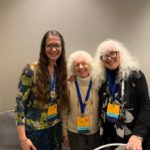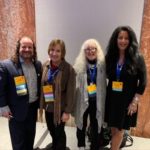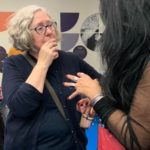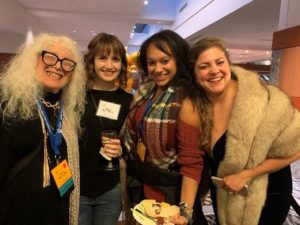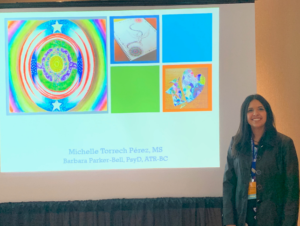American Art Therapy Association Conference
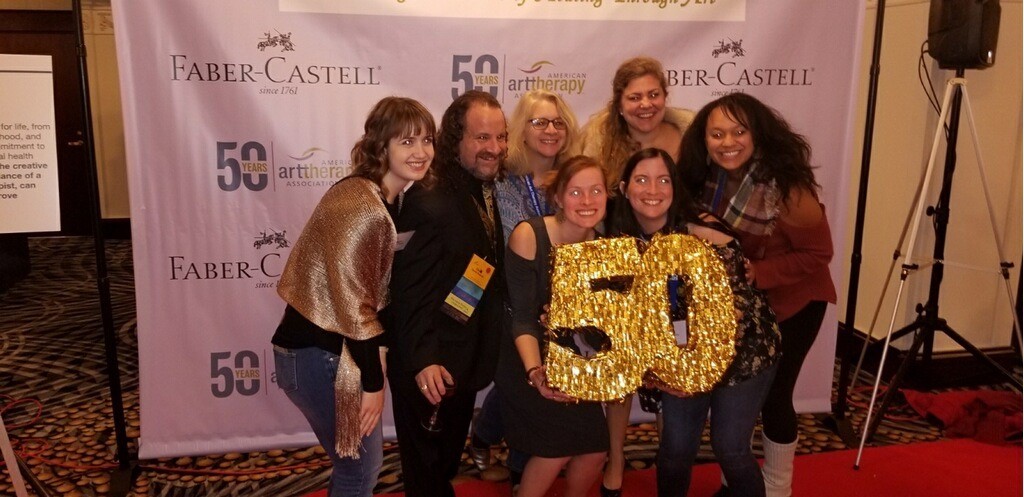
Drs. Gussak and Parker-Bell celebrated at the 50th anniversary event with students Meg Buzby, Katrina English, Heather Robbins, Rachel Nelms, and Danielle Tidwell.
The professors, students, and alumni of FSU’s Art Therapy program, recently attended and took part in the 50th Annual American Art Therapy Association Conference in Kansas City, Missouri, from October 30-November 2, 2019. The conference was a huge milestone for the field of art therapy, and FSU had the privilege to be represented through its presentations and attendees.
Dr. Nancy Gerber and Dr. Theresa Van Lith from the FSU department of art education presented on “Considering a Strategic Plan for Research in Art Therapy”.
Since the profession’s inception, the political, socio-economic, and scientific climate has changed demanding that we provide substantive and credible evidence demonstrating goals, applications, mechanisms, and outcomes for art therapy. The call for evidence requires that the field of art therapy commits to a new era in which we critically and systematically examine our worldview, our current body of knowledge, epistemologically relevant evidence, strategic stakeholders, educational expansion, and future directions. We proposed that a decisive and realistic strategic research plan will examine and formulate a pluralistic worldview; evaluate research philosophies and methodologies that retain both rigor and the epistemological integrity of the field, and create a clear strategy for research in art therapy that will contribute to the efficacy, sustenance, growth, and overall health of our profession.
Dr. Nancy Gerber moderated a panel with Dr. Patricia St. John and Jennifer Schwartz entitled: “The Art Therapy Educational Continuum: Undergraduate to the Doctorate”. In recent years, art therapy education has evolved beyond the traditional entry level clinical master’s degree. This panel discussed the purpose, philosophy, objectives, competencies, curricula, and pedagogies for each level of education, as well as how these educational elements at each level inter-relationally contribute to the comprehensiveness and the development of art therapy clinicians, scholars, and advancement in the field.
- Dr. Nancy Gerber moderated a panel with Dr. Patricia St. John and Jennifer Schwartz
- Drs. Nancy Gerber, David Gussak, Lynn Kapitan and Jennifer La Civita
- Professor Emerita enjoying conversation with an esteemed colleague.
Drs. Nancy Gerber, Moderator, David Gussak, Lynn Kapitan and Jennifer La Civita presented a panel on “Art Therapy Doctoral Studies: Changing Perspectives, Shaping Art Therapy’s Future”. After years of calling for robust research to help sustain the profession within evidence-based healthcare and related disciplines (Campanelli, Lusebrink, & Rosal, 1993; Gerber, 2006; McNiff, 1986), art therapists are advancing art therapy’s collective knowledge by developing doctoral programs and doctorally prepared scholars or stewards of the profession.
This panel described the unique environments that have seeded this relatively new development, highlighting several questions that are important in creating a unifying perspective on the goals and purposes of doctoral degrees in art therapy. Current trends, changing circumstances, and challenges to future growth and viability were examined, as well as career value, risks, and benefits of earning a doctoral degree in art therapy.
- Faculty member, Dr. Nancy Gerber, students Meg Buzby, Danielle Tidwell, and Rachel Nelms join in on the celebration.
- FSU graduate Michelle Torrech Perez
AATA held a 50th anniversary event on Thursday of the conference. FSU worked with Emporia State University and Notre Dame de Namur University to collaboratively plan an event for all their alumni and friends attending the conference which allowed everyone to connect and reminisce about their experiences.
Recent FSU graduate Michelle Torrech Perez, with the support of Dr. Barbara Parker-Bell, presented on her culminating project, “Are We Practicing What We Preach? Examining Applied Multicultural Competence”. Promoting multicultural competency is a goal of the American Art Therapy Association. Given the current cultural and political climate, there is an increasing need for more informed practice. Acknowledging this need, the presenter surveyed credentialed art therapists about their practices related to culturally informed methods. The presentation explored the responses and experience of the art therapists, and reflected on multiculturalism, multicultural competence, and culturally attuned art therapy practices.

Marilyn Proctor, Terri Corbett, Cheryl Sattler, Dr. Barbara Parker-Bell and Sarah Holz
Dr. Barbara Parker-Bell presented on “Strong of Heart: Designing a Fused Glass Project to Support Student Resilience”. Our society stands witness to an ever-increasing degree of violence. In particular, there have been increasing incidents of school violence which rattle society has a whole, but can have a profound impact on students. In response to this current environment, a glass artist and an art therapist collaborated to create the Strong of Heart Project to support student resilience. This presentation will examine a description of the glass sculpture protocol and initial feedback from students and teachers.
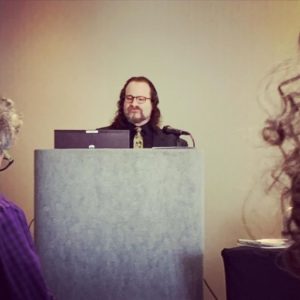
Dr. Dave Gussak also presenting the paper “Twenty-five Years Exploring the Frenzied Tango of Art and Violence”.
Dr. Dave Gussak also presented the paper. “Twenty-five Years Exploring the Frenzied Tango of Art and Violence”. As an introduction to his current publication project, this paper presentation explored and clarified the interrelationship between art and violence–that while aggression feeds creative expression art making simultaneously mitigates violence. To do so, Dr. Gussak relied on historical accounts and contemporary narratives of violent artists as well as personal experiences as an art therapist with violent offenders and aggressive clients.
The students, alumni, and faculty of FSU’s Art Therapy Program were excited to be a part of this historical conference. The attendees took part in many presentations, celebrations, and learning opportunities to continue advancing the Art Therapy Program at FSU as well as the art therapy field. Excitement is already building for the 51st Annual AATA Conference in Washington, DC next year.
